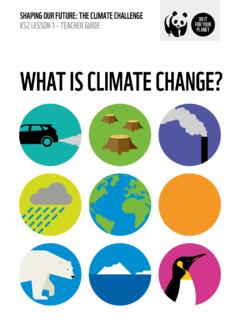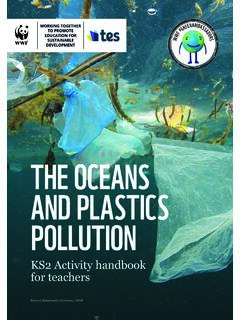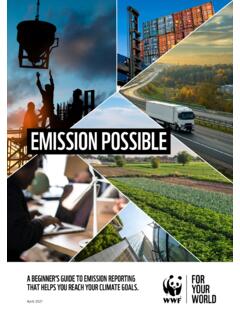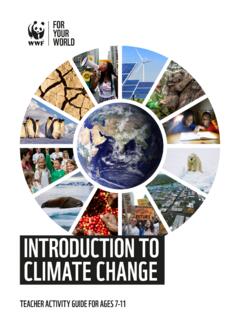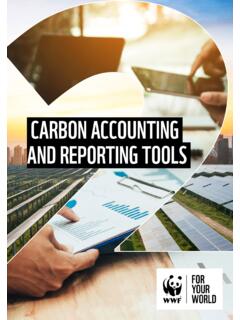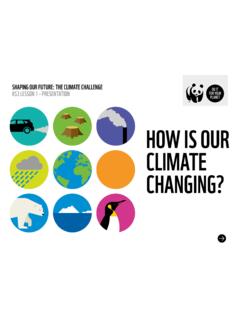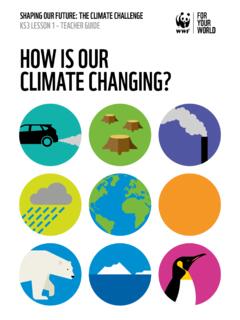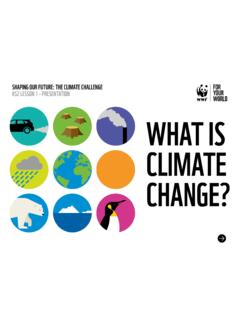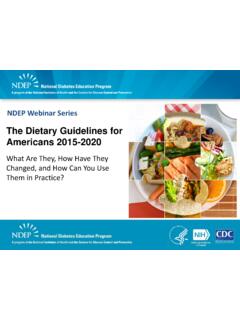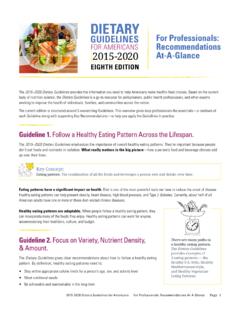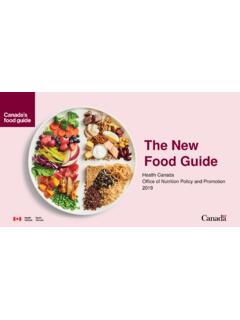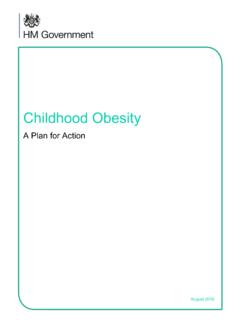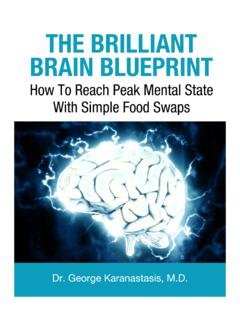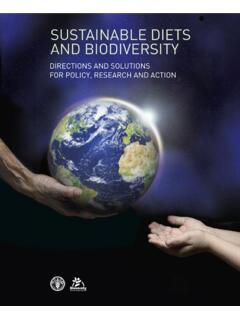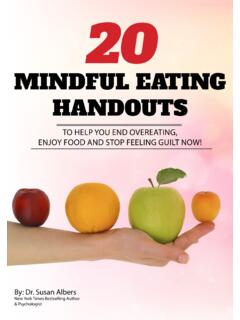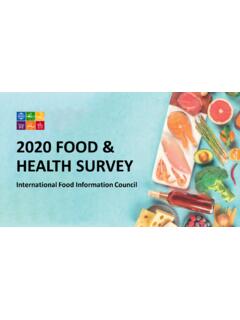Transcription of healthier planet
1 50 foods for healthier people and a healthier planetFUTURE 50 FOODSOUR WORLD IS FACING AN UNPRECEDENTED CHALLENGEBy 2050 the world population is predicted to increase to almost ten billion people whom we must nourish on a planet of finite resources. It is well-documented that to do this we need to transform our global food system from the way we farm and fish to what we choose to eat. It is a complex task, and if we are to deliver nutritious food to all, everyone needs to play a part in making the food system more sustainable. Large scale, practical solutions are essential to make the required we rely on a small range of foods. This negatively impacts our health and the health of the planet . Seventy-five percent of the global food supply comes from only 12 plant and five animal species. Just three (rice, maize, wheat) make up nearly 60 percent of calories from plants in the entire human diet1. This excludes many valuable sources of nutrition.
2 While people may be getting sufficient calories, these narrow diets don t provide enough vitamins and minerals. Dietary monotony is linked to a decline in the diversity of plants and animals used in and around agriculture (agrobiodiversity), threatening the resilience of our food system and limiting the breadth of food we can eat. Since 1900, a staggering 75 percent of the genetic plant diversity in agriculture has been lost2. In most Asian countries, the number of rice types grown has decreased rapidly from thousands to a dozen. In Thailand, for example, the 16,000 varieties once cultivated have dropped to just 37 varieties3. In the past century, the United States has lost 80 percent of its cabbage, pea and tomato varieties. This dependence on a limited pool of crop species leaves harvests vulnerable to pests, diseases and the impact of climate change. Farming a narrow range of crops using intensive methods can have serious repercussions on our fragile natural ecosystems.
3 Monoculture farming, which is the repeated harvesting of a single crop, and over-reliance on animal-based foods are threatening food security. Monoculture farming can deplete nutrients and leave soil vulnerable to the build-up of pests and pathogens. This requires applications of fertilisers and pesticides that can, if used inappropriately, damage wildlife and leach into water systems4, 5. Many types of birds, animals and wild plants cannot thrive in biologically degraded landscapes. Reliance on animal-based protein sources puts additional strain on our environment and current agricultural practices are not sustainable in the long term. Total agriculture accounts for around a quarter of all greenhouse gas emissions, of which approximately 60 percent is due to animal agriculture6. Meat, dairy and egg production is more water, land and greenhouse gas intensive than plant production. It also contributes to pollution through liquid waste discharged into rivers and seas.
4 These problems seem insurmountable, but we believe that large scale change starts with small actions. Most of us might believe it s our energy or transport choices that cause the most serious environmental damage. In fact, it s our food system that creates the biggest impact. Dr. Tony Juniper, CBE, Executive Director for Advocacy, WWF-UK Diversified diets not only improve human health but benefit the environment through diversified production systems that encourage wildlife and more sustainable use of resources. Peter Gregory, Research Advisor, Crops For the FutureEATING TO IMPROVE THE food SYSTEM350 FOODS FOR healthier PEOPLE AND A healthier planet The search for nutrient-dense plants has taken us toward ancient grains, heirloom plant varieties, and less commonly cultivated crops. There is a good reason for rediscovering some of the forgotten plants. Dr. Adam Drewnowski, Director of The Center for Public Health Nutrition, University of WashingtonKnorr and WWF have a shared ambition to drive change, which is why we, in partnership with Dr.
5 Adam Drewnowski, Director of The Center for Public Health Nutrition at the University of Washington, have collaborated to create The Future 50 foods Report. In a world cluttered with advice and pressure around what not to eat, we want to provide people with more food choices to empower positive change. For this reason, we have identified 50 foods we should eat more of because they are nutritious, have a lower impact on our planet than animal-based foods, can be affordable, accessible and taste list of Future 50 foods , consisting of vegetables, grains, cereals, seeds, legumes and nuts from across the globe, has been developed to inspire greater variety in what we cook and eat. It is intended to enable three important dietary shifts . First, a greater variety of vegetables to increase intake of vitamins, minerals and antioxidants. Second, plant-based sources of protein to replace meat, poultry and fish, resulting in reduced negative impact on our environment.
6 Third, more nutrient-rich sources of carbohydrates to promote agrobiodiversity and provide more nutrients. By joining together with our partners, we believe we can shift the way food is grown and the foods people choose to eat, delivering significant, positive impact on the food system. Our mission is simple: make delicious, nutritious, and sustainable food accessible to all. April Redmond, Global Vice President, KnorrNot all 50 foods are currently easily accessible. Working together with partners allows us to make these foods more commonly grown and more widely eaten. By making a conscious choice to consume more of the Future 50 foods , we take a crucial step towards improving the global food system. Swapping staples like maize and white rice for fonio or spelt increases the nutrient content of a dish while contributing to greater agrobiodiversity, making our food supply more resilient. It also helps safeguard these ancient variants for future generations.
7 These 50 foods are some of the many that we can and should eat. According tothe food and Agriculture Organization of the United Nations (FAO), there are between 20,000 and 50,000 discovered edible plant species, of which only 150 to 200 are regularly consumed by humans7. Future 50 foods is the beginning of a journey and a way for people to make a change, one delicious dish at a time. 4 FUTURE 50 FOODSCRITERIA FOR THE FUTURE 50 foods The Future 50 foods have been selected based on their high nutritional value, relative environmental impact, flavour, accessibility, acceptability and affordability. This set of criteria is modelled after the food and Agricultural Organization s (FAO) definition of sustainable diets. Some of the Future 50 foods have higher yields than similar crops, several are tolerant of challenging weather and environmental conditions, and many contain significant amounts of critical nutrients. Each has a story to the full methodology at the end of the discovery of a new dish does more for the happiness of the human race than the discovery of a famously said by French gastronome, Jean Anthelme Brillat-Savarin 550 FOODS FOR healthier PEOPLE AND A healthier PLANETFUTURE 50 foods IS THE BEGINNING OF A JOURNEY AND A WAY FOR PEOPLE TO MAKE A CHANGE, ONE DELICIOUS DISH AT A TIME.
8 Algae are nutrient-rich and critical to our existence on the planet . They are responsible for half of all oxygen production on Earth and all aquatic ecosystems depend on them. They contain essential fatty acids and are an excellent source of antioxidants. Algae can be rich in protein and have a meat-like umami flavour, making them a potential replacement for meat8, seaweed Porphyra umbilicalis1 CategoryAlgaeLaver is a variety of red algae known for its link to Japanese cuisine. Called nori in Japan and most commonly used for wrapping sushi, laver is heralded for its exceptional nutrient content and ability to bring out the umami flavour in foods. Umami is the flavour profile that meat provides and is commonly missed in plant-based seaweed cultivation has been suggested to be a game- changer10 in the food system. Because it lives wildly in the water, laver seaweed can be grown and harvested throughout the year and does not require pesticides or fertilisers.
9 Laver seaweed is rich in vitamin C and iodine11. Laver is often consumed dried as a topping for soups and salads. In Korea, it is eaten dried as a savoury snack and is referred to as gim . In the UK, especially in Wales, laver is used to make laverbread, a dish in which the fresh seaweed is slow-cooked, seasoned and traditionally served with hot, buttered toast. Some say people in Wales have been eating laver since the first inhabitants arrived; others say it was introduced by the 50 FOODS8 FUTURE 50 FOODS8 CategoryAlgaeWakame seaweedUndaria pinnatifida2 Cultivated for centuries by sea farmers in Korea and Japan, deep-green coloured wakame is rich in nutrients and easy to grow. Maintaining similar properties to other seaweeds, it can be harvested all year round, grows rapidly without the use of fertilisers or pesticides and supports the water s biological balance. Beyond Asia, it is farmed in sea fields in France, New Zealand, California and addition to containing a variety of vitamins and minerals, wakame is one of the few plant-based sources of the omega 3 fatty acid EPA (eicosapentaenoic acid), which is found almost exclusively in fatty fish that feed on algae12.
10 Most commonly sold dried and then rehydrated, wakame has a savoury flavour and satin-like texture. It can be chopped and added to soups or fried and thrown into salads, stir-fries, and side dishes for a salty, umami flavour. 950 FOODS FOR healthier PEOPLE AND A healthier PLANET950 FOODS FOR healthier PEOPLE AND A healthier planet We work with hundreds of thousands of smallholder farmers in many countries in sub-Saharan Africa to garner the benefits of nitrogen-fixing grain legumes. It s no surprise that many legumes made it onto the Future 50 foods list. Professor Ken Giller, Wageningen University, N2 AfricaN2 Africa is a research-in-development project focused on putting nitrogen-fixing to work on smallholder farms in sub-Saharan Africa13 Beans and other pulses are members of the legume family. They can convert nitrogen from the air and fix it into a form that can be readily used by plants. More than environmental superheroes, beans offer us a rich source of fibre, protein and B vitamins.

